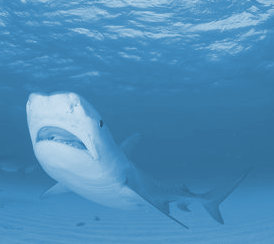Sharks spy on seagrass
 Sharks with GoPros are helping to reveal the ocean's secrets.
Sharks with GoPros are helping to reveal the ocean's secrets.
Tiger sharks with cameras strapped to their backs have helped researchers map what could be the largest seagrass system in the world.
International researchers used a combination of footage from the sharks as they travelled The Bahamas with human diver surveys to estimate the size of the seagrass system across the Bahama Banks.
They found the seagrass covers at least 66,000 square kilometres, potentially up to 92,000, which would make it the biggest seagrass system in the world, larger than the 40,000 square kilometre system off the coast of Queensland.
Seagrass ecosystems play a key role in supporting carbon sequestration, ocean biodiversity and fishery resources.
They are estimated to account for 17 per cent of the carbon sequestered in marine sediments annually. The effective conservation of seagrasses and their potential to provide nature-based solutions to climate change is therefore of critical importance.
However, it is currently hindered by uncertainties regarding the size and distribution of seagrass ecosystems.
Tiger sharks have a strong preference for seagrass habitats, and so the authors used data from 15 instrument-equipped tiger sharks to track their locations and collect images of the seafloor.
This data was then combined with over 2,500 surveys performed by human divers to assess the presence of seagrass and integrated with existing estimates of seagrass cover.
They say their estimates expand the global extent of seagrass area by around 34 per cent, which highlights the importance of this region as a globally relevant carbon sink.
The full study is accessible here.








 Print
Print